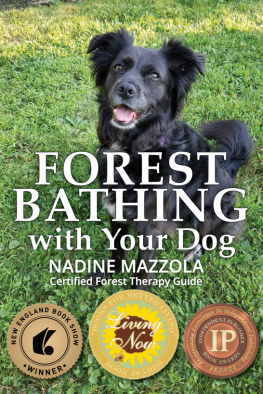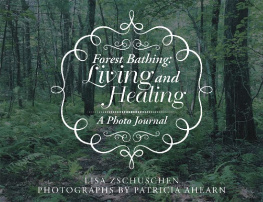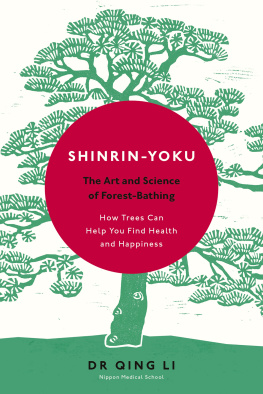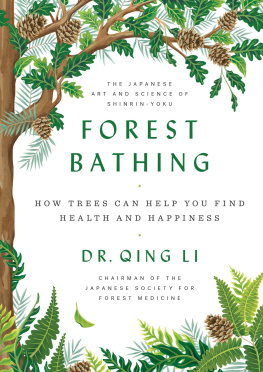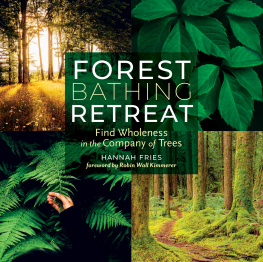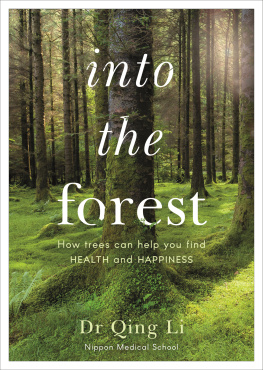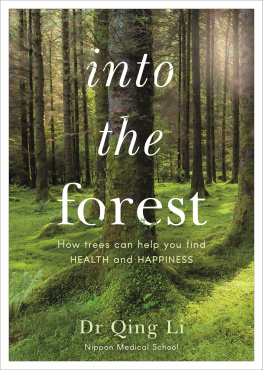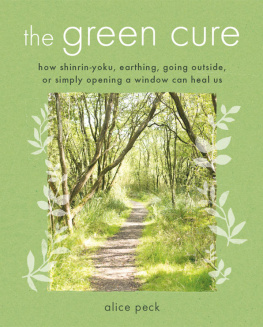Forest Bathing
The No Nonsense Guide to Shinrin Yoku
Copyright 2019 by Jim Garlits
All rights reserved. No part of this publication may be reproduced, distributed, or transmitted in any form or by any means, including photocopying, recording, or other electronic or mechanical methods, without the prior written permission of the publisher, except in the case of brief quotations embodied in critical reviews and certain other noncommercial uses permitted by copyright law. For permission requests, write to the publisher, addressed Attention: Author at
jgarlits at gmail dot com
Dedication
For Tony Pompa and Tiffany Meicher-Schneller, who allowed me to tag along on one of their True North Expeditions adventures in Shenandoah National Park and gave me the hike of my life. Your camaraderie was only matched by your technical skills on the trail. I feel privileged to call you my friends.
Introduction
A Buddhist monk walks up to a hot dog vendor and says make me one with everything. It is an old joke, but still funny enough to make us chuckle. Being out in nature is sort of like that hot dog transaction. It makes you feel like you are one with everything. When passing through the urban landscape of our modern existence, many of us feel like we are disconnected from the natural environment. Buildings tower over us. Cars and trucks whiz by on wide concrete ribbons. Billboards and advertisements scream at us from every available space. Many of us cocoon ourselves in our houses, and safely tucked away there, we stare at our screens. There is strong evidence, increasingly backed by science, that immersing ourselves in nature offers a host of benefits for our health and general well-being. The list of chronic and debilitating diseases and disorders that afflict most of us is dizzying. You may or may not be impressed with the upcoming list of ailments that nature therapy has successfully treated, or at least to which it has contributed positive outcomes. But I stuck them up front for a reason: You may be more likely to continue reading and actually head out into the forest if you see your own particular ailment listed, and read about the positive effect that nature therapy has had on it in others like you.
The title of this book, Forest Bathing: The No Nonsense Guide to Shinrin Yoku requires an explanation and simplification before we proceed. There are many names being used for the framework presented here. Nature therapy is the most benign and the most broad, perhaps the least scary or off-putting, too. There are many types of nature therapy, practiced and recommended by physicians, psychiatrists, psychologists, holistic medicine practitioners, public health officials and guides. I appreciate the science and research that has gone into study of natures effects on the human body and mind, especially of late, and specifically as introduced in Japan. For this reason, the practices included here are based heavily on what is called Shinrin Yoku, roughly translated into English as forest bathing. From here on out, I will refer to it comfortably as forest bathing or simply bathing. It will save some repetition. I also want to point out that Im not a physician, nor am I a psychiatrist, a psychologist, a holistic or natural medicine practitioner, a public health official, an herbalist, a shaman, or a guide.
The premise of this book is that you dont need an acronymed, business card carrying forest bathing guide to shuttle you to the woods to teach you the ultra-spiritual secret to summoning naiads and talking to rocks. The positive health and wellness benefits of forest bathing are not spiritual, though many people who practice them are spiritual, and come from many different spiritual traditions. The health and wellness effects are the same for the Methodist, the Mormon, and the Muslim.
I have never been against stuffing a few bills into a shuttle drivers fist if he was willing to drop me off at a trailhead, but that is a service fairly bought and paid for. But you dont need to pay anyone to guide you into nature to learn forest bathing. Nature has always been there; guides, not so much. Some people pay others to do things for them that they dont want to do themselves, but nobody can go into the woods for you , and honestly getting there is the hardest part. So dont feel bad about paying someone to drive you to the woods if you need a lift, but dont give them a penny to guide you unless theyre willing to carry all the heavy stuff, cook your food, make sure you dont get lost, splint your broken leg, and carry you back to the trailhead if you slide down a rock outcropping. That would be money well spent.
People who lived even a few generations ago didnt need an experience called forest bathing, because they were out in nature every day silently and ignorantly reaping its benefits. They lived their lives in the natural environment. They didnt know, and therefore didnt care, that trees use chemical messages to communicate with each other, or that we benefit from breathing in those chemicals messages, called phytoncides. They didnt know that trees share nutrients with each other through an intricate network of roots and fungal filaments, or that they can decide as a group whether to share nutrients with a tree of another species if they sense it is struggling and perceive a benefit in keeping it healthy. People simply walked, and breathed, and looked, and listened, and ate and got dirt on them like we all should.
I have to admit, being a forest bathing guide sounds like a great scheme for making money from people who need to get into the woods and just be there for a while. And I admit that there are a sprinkling of people in this world who have invested a lot of time and resources into building a curriculum to get people into the woods, this piece appealing to the tree-hugger, that one to the scientist, and a third to the PTSD afflicted veteran of the global war on terrorism. I have friends in all of those camps, but my argument to you is that you dont even need to know what is happening to reap most the benefits of forest bathing if you just follow a handful of easy to follow steps, just as you dont have to know the chemical makeup of beer or wine to enjoy its taste.
Seems sort of simplistic, doesnt it? Let me ask you this. Did anyone have to tell you when you were a kid lay on the ground and imagine shapes in the clouds? Or to go into a trance watching the red and orange glow in the coals on a campfire log? Nature often works its magic invisibly and unannounced. So, in many instances, our bodies react positively to the forest conditions without our even knowing it. We may sense some of the effects immediately. Others may follow on quickly or slowly, but the cumulative effects can last for days.
Why is forest bathing so important today? After the industrial revolution, we really lost our way when it comes to nature. We stopped viewing it as our home environment and started viewing nature as a spreadsheet of inexhaustible products to be extracted, transformed, and sold at market. There was an immediate and robust counter-reaction. Americans gained a cursory knowledge of the what of nature therapy from the naturalist quacks of the nineteenth century and for a while people began returning to nature via the lodges and health spas that popped up especially on the coasts. That is when camping became popular. Most recently we have learned from those brilliant Japanese health officials and scientists who pioneered the concept of Shinrin Yoku ) that contact with nature has a host of positive benefits. And Im sure we havent yet learned the tenth of it all. But today, you can shoulder your way into the forest and bathe there just fine all by yourself, armed with this simple framework, a thermos of potable liquid, and a snack. Some people make the distinction between forest bathing and forest therapy. They say that if youre wanting forest therapy, then you need a trained specialist to accompany you. I have reservations about that.



